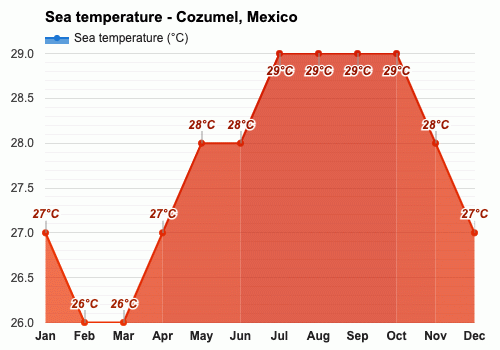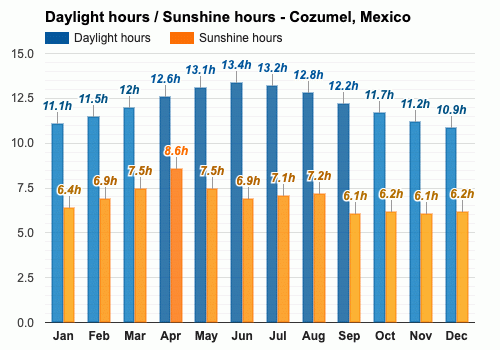
Weather in March
Temperature
Cozumel experiences a recorded average high-temperature of a hot 30.9°C (87.6°F) in March, closely aligned with February's 29.1°C (84.4°F). During March, Cozumel's temperature falls to a steady low-temperature average of 20.7°C (69.3°F).Heat index
For March, the heat index is estimated at an extremely hot 40°C (104°F). Adopt extra safety steps, risk of heat exhaustion and heat cramps is notable. Sustained activity might cause heatstroke.For clarity, heat index numbers account for light winds and areas under shade. The presence of direct sunlight can raise the heat index values by up to 15 Fahrenheit (8 Celsius) degrees.
Note: The heat index, also known as 'real feel' or 'feels like', is a composite of temperature and humidity figures to convey how warm it feels. The impact of temperature is individual, as people's perception of weather may change based on their body mass, height, and physical activity. Do note, being directly under sun rays can amplify the heat you feel, potentially raising the heat index by 15 Fahrenheit (8 Celsius) degrees. Heat index values are largely significant for babies and toddlers. Children regularly disregard the necessity to rest and replenish fluids. Thirst is a late symptom of dehydration - thus, maintaining hydration, particularly during long-lasting physical activities, is essential.
The human body normally cools itself by perspiration. Excessive warmth is eliminated from the body by evaporation of sweat. Excessive relative humidity disturbs the body's typical cooling process by reducing evaporation, leading to a decrease in body cooling rate and an increase in the sensation of warmth. Overheating and dehydration threats arise when heat gain goes beyond what the body can comfortably shed.
Humidity
The months with the lowest humidity are March and April, with an average relative humidity of 79%.Rainfall
March is the month with the least rainfall. Rain falls for 4 days and accumulates 32mm (1.26") of precipitation.Sea temperature
The months with the coldest seawater are February and March, with an average sea temperature of 26°C (78.8°F).Note: Water temperatures between 25°C (77°F) and 29°C (84.2°F) are ideal for all water activities, offering enjoyment without causing discomfort over extended periods.
Daylight
In Cozumel, the average length of the day in March is 12h and 3min.On the first day of March in Cozumel, sunrise is at 7:06 am and sunset at 6:52 pm. On the last day of the month, sunrise is at 6:41 am and sunset at 7:02 pm EST.
Sunshine
In Cozumel, the average sunshine in March is 7.5h.UV index
In Cozumel, the average daily maximum UV index in March is 11. A UV Index value of 11, and more, symbolizes an extreme threat to health from unprotected exposure to Sun's UV rays for the average person.Note: A daily high UV index of 11 in March leads to these guidelines:
Practice all essential precautions. Protection against sun damage is crucial. Stay in the shade and avoid direct Sun exposure from 10 a.m. to 4 p.m., a period when UV radiation is particularly strong, noting that parasols or canopies may not offer total sun protection. Sunglasses that guard against UVA and UVB rays are pivotal in minimizing sun-induced ocular damage. Frequent reapplication of a broad-spectrum SPF 30+ sunscreen is vital every two hours or directly after a swim or an outdoor workout. Attention! UV strength is notably upped by the reflection of sand and water.
Published by: Weather Atlas | About Us
Data Sources | Weather Forecasting & Climate
Frequently asked questions
How hot does it get in March?
What is the least humid month?
What is the average humidity in March?
What is the driest month?
How much does it rain in March?
What months are the sea coldest?
What is the sea water temperature in March?
How many hours of daylight does Cozumel have in March?
When are sunrise and sunset in March?
How long on average sun shines in March?
How high is the UV index in March?
Average temperature in March
Cozumel, Mexico

- Average high temperature in March: 30.9°C
The warmest month (with the highest average high temperature) is August (33°C).
The months with the lowest average high temperature are January and December (28.6°C).
- Average low temperature in March: 20.7°C
The month with the highest average low temperature is June (23.8°C).
The coldest months (with the lowest average low temperature) are January and February (19.4°C).
Average humidity in March
Cozumel, Mexico

- Average humidity in March: 79%
The month with the highest relative humidity is September (87%).
The months with the lowest relative humidity are March and April (79%).
Average rainfall in March
Cozumel, Mexico

- Average rainfall in March: 32.2mm
The wettest month (with the highest rainfall) is October (242.5mm).
The driest month (with the least rainfall) is March (32.2mm).
Average rainfall days in March
Cozumel, Mexico

- Average rainfall days in March: 4 days
The month with the highest number of rainy days is October (15.7 days).
The month with the least rainy days is April (3.7 days).
Average sea temperature in March
Cozumel, Mexico

- Average sea temperature in March: 26°C
The best months for swimming (with the highest average sea temperature) are July, August, September and October (29°C).
The coldest months (with the lowest average sea temperature) are February and March (26°C).
Average daylight in March /
Average sunshine in March
Cozumel, Mexico

- Average daylight in March: 12h and 0min
The month with the longest days is June (Average daylight: 13h and 24min).
The month with the shortest days is December (Average daylight: 10h and 54min).
- Average sunshine in March: 7h and 3min
The month with the most sunshine is April (Average sunshine: 8h and 36min).
The months with the least sunshine are September and November (Average sunshine: 6h and 6min).
Average UV index in March
Cozumel, Mexico

- Average UV index in March: 11
The months with the highest UV index are April, May, June, July and August (UV index 12).
The months with the lowest UV index are January and December (UV index 7).
Cozumel, Mexico
Weather forecast for your location
2. Allow the app to use your location


